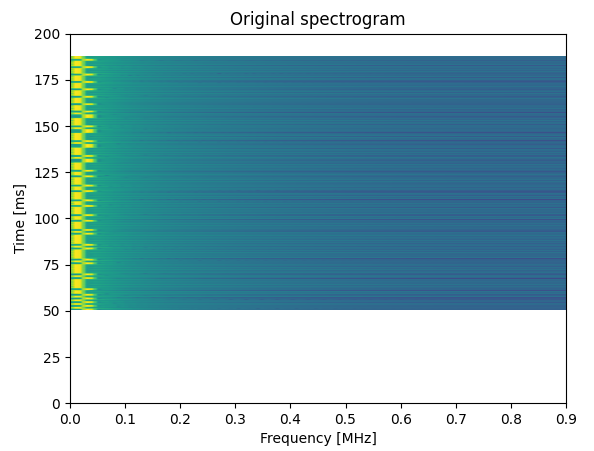I'm want to generate the IQ components of a FSK signal using numpy and then try to demodulate the resulting IQ samples by looking at the derivative of its phase in time.
This is the script I have:
import numpy as np
import matplotlib.pyplot as plt
from scipy import signal
fs = int(1.8e6) # Hz
rb = int(1e3) # bps
message = b"AAAABBBBCCCCDDDD"
f_one = 30e3
f_zero = 10e3
fc = (f_one + f_zero) / 2
t = np.arange(0, 0.2, 1 / fs)
x = np.zeros(np.size(t))
start_t = 0.05
start_i = int(fs * start_t)
samples_per_bit = fs // rb
print(f"Each bit takes: {samples_per_bit} samples, {samples_per_bit / fs * 1e3:.2f} ms")
bit_index = 0
for i in range(10):
tempslice = slice(
start_i + bit_index * samples_per_bit,
start_i + (bit_index + 1) * samples_per_bit
)
if i % 2 == 0:
x[tempslice] = np.cos(2*np.pi*f_one*t[tempslice])
else:
x[tempslice] = np.cos(2*np.pi*f_zero*t[tempslice])
bit_index += 1
for byte in message:
for i in range(8):
one = (byte >> (7 - i)) & 1
tempslice = slice(
start_i + bit_index * samples_per_bit,
start_i + (bit_index + 1) * samples_per_bit
)
if one:
x[tempslice] = np.cos(2*np.pi*f_one*t[tempslice])
else:
x[tempslice] = np.cos(2*np.pi*f_zero*t[tempslice])
bit_index += 1
plt.figure()
plt.title("Signal vs time")
plt.plot(t * 1e3, x)
plt.ylabel("Amplitude")
plt.xlabel("Time [ms]")
### Plot spectogram ###
fft_size = 256
num_rows = len(x) // fft_size
spectrogram = np.zeros((num_rows, fft_size))
for i in range(num_rows):
w = x[i*fft_size:(i+1)*fft_size] * np.hamming(fft_size)
spectrogram[i, :] = 20*np.log10(np.abs(np.fft.fftshift(np.fft.fft(w))))
spectrogram = spectrogram[:, fft_size//2:]
plt.figure()
plt.imshow(spectrogram[::-1,:], aspect='auto', extent = [0, fs/2/1e6, 0, len(x)/fs * 1e3])
plt.title("Original spectrogram")
plt.xlabel("Frequency [MHz]")
plt.ylabel("Time [ms]")
### IQ SAMPLING ###
I = x * np.cos(2*np.pi*fc*t)
Q = x * np.sin(2*np.pi*fc*t)
s = I + 1j * Q
plt.figure()
plt.plot(t * 1e3, np.real(s), label="I")
plt.plot(t * 1e3, np.imag(s), label="Q")
plt.title("After sampling")
plt.ylabel("Amplitude")
plt.xlabel("Time [ms]")
plt.legend()
plt.figure()
plt.plot(I, Q,'.')
plt.title("Constelation")
# Recover signal
plt.figure()
plt.plot(t, I*np.cos(2*np.pi*fc*t) + Q*np.sin(2*np.pi*fc*t))
plt.title("Signal from IQ")
plt.ylabel("Amplitude")
plt.xlabel("Time [ms]")
### FSK DEMODULATION ###
real = np.real(s[:-1]) * np.real(s[1:]) - np.imag(s[:-1]) * np.imag(s[1:])
imag = np.real(s[:-1]) * np.imag(s[1:]) - np.imag(s[:-1]) * np.real(s[1:])
phase_der = np.arctan2(imag, real)
plt.figure()
plt.plot(t[:-1] * 1e3, real, label="I")
plt.plot(t[:-1] * 1e3, imag, label="Q")
plt.title("After demodulation")
plt.ylabel("Amplitude")
plt.xlabel("Time [ms]")
plt.legend()
plt.figure()
plt.plot(t[:-1] * 1e3, np.sign(phase_der))
plt.title("Phase derivative")
plt.ylabel("Amplitude")
plt.xlabel("Time [ms]")
plt.show()
This is a closeup on the time signal I generate from the bitstream and its spectrogram. As you can see I chose very low frequencies for FSK so that I can see easily the effect of this modulation:
Then I try to get the IQ samples and convert it to complex numbers by:
I = x * np.cos(2*np.pi*fc*t)
Q = x * np.sin(2*np.pi*fc*t)
s = I + 1j * Q
From this I plot the constellation diagram. This is the part I don't understand. I was expecting the constellation to show a perfect circle of unit radius, but this is what I get:
Can anyone shine a light here? I reckon this has something to do with the way I calculate the IQ components, but I can't figure out what would be the correct way to do it. I also tried to recover the time signal from the IQ samples and I get exactly the same signal, so I don't know:







